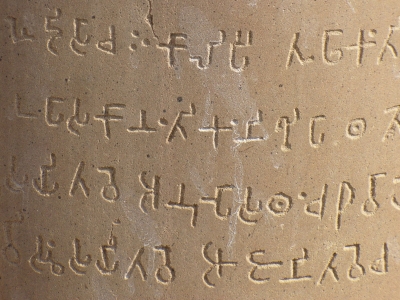
The Phonetic Phoenicians
When early forms of writing first developed in different parts of the works humans drew picture symbols to show what they observed in real life. So each symbol represented one object. The Egyptian Hieroglyphs, the Mesopotamian Cuneiform, and the Indus Valley script were all ‘pictorial’ scripts. This meant that to read or write, people had to learn lots and lots of symbols, which was very difficult and took a lot of time.
Around 1500 BC, the ancient Phoenicians, an ancient sea-faring, trading civilization based around what is now Lebanon, came up with a system of writing that would change the world! Symbols were now used for sounds rather than actual words. These sounds became alphabets, which didn’t mean anything by themselves, but could be used as building blocks to form an unlimited number of words. Even unknown words could be spelled out as people now knew how to pronounce them. All cultures which came in contact with this immediately adopted this revolutionary concept, and created their own ‘phonetic’ alphabets.
However, the Chinese alphabet remains pictorial. So while writers of most languages of the world have to learn, and focus only on building their vocabulary, the average Chinese person today has to learn, by heart, between 3,000 and 50,000 characters just to be able to read her language!
The Greeks and Roman scripts became the base for the European language scripts used today. The Hebrews* and Arabs modified Phoenician differently and created their own scripts, including the Aramaic script, which was adopted as the official script of the Persian Empire. With the Persian conquests of the Indus area in the 6th century BC, the Aramaic script came to India.
Origin of Indian scripts
In India, the Harappan script was by then a long forgotten mystery. After a gap of thousands of years, the earliest inscriptions are from the Mauryan period, in the Hathigumpha in Orissa, and the Ashokan edicts in the 3rd century in a script called Brahmi. Interestingly, Emperor Ashoka’s very first edict, carved into a rock near Kandahar around 260 BC, was written exclusively in Aramaic and Greek!
However, Brahmi and other scripts had probably been gradually evolving for a long time in India and it is just that the oldest ones we have found are from the Maurayan period, as they started carving things into durable stone, rather than writing on wood or paper.
Brahmi would become the mother of all South Asian and most South-East Asian scripts – around 15 of them – from Hindi to Punjabi to Bengali to Tamil to Burmese, Thai and Tibetan!
Variations in Brahmi
Like languages, scripts also change across different regions. Brahmi quickly started getting regional variations. Around the 1st century, there was a distinct split between Northern Brahmi and Southern Brahmi , which diverged more and more over time. Northern Brahmi evolved into all the north Indian scripts we have today, like Gurmukhi, Devanagari, Marathi, Bengali and so on. Southern Brahmi gradually morphed into the Old Kannada, Pallava grantha and Vattelutu scripts, which gave rise to modern Tamil, Telugu, Kannada and Malayalam.
The South-East Asian Connection
The Pallava dynasty ruled a large swathe of southern India around the 3rd-9th centuries AD. In their time, a script called Pallava Grantha was used. The Pallavas developed strong trading ties with many countries in South-East Asia, and not just goods, but Indian culture, religion, mythology and even the script spread to countries like modern Burma, Indonesia, Thailand Cambodia and Vietnam. All of their scripts come from Pallava Grantha!
Vowels and Consonants
Have you ever wondered why, in English, vowels are written as separate letters, but in Indian scripts, the vowels are added to the top, bottom or side of the consonants> this is special feature of all Brahmic scripts. While it makes learning to write a bit more complicated, it is at least less complicated than Semitic languages like Arabic and Hebrew…which simply don’t have vowel sounds! Readers of those languages have to guess what the word is while reading the paragraph!
Picture Credit : Google
